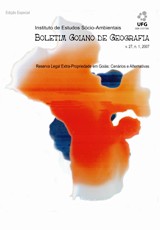SISTEMA DE RESERVA LEGAL EXTRA-PROPRIEDADE EM GOIÁS: ANÁLISE DE CUSTO E BENEFÍCIOS ECONÔMICOS E AMBIENTAIS À ESCALA DA PAISAGEM - DOI 10.5216/bgg.v27i1.3440
DOI:
https://doi.org/10.5216/bgg.v27i1.3440Palavras-chave:
gestão territorial, SEUC, reserva legalResumo
Aproximadamente 47% do bioma Cerrado, um dos hotspots de biodiversidade no mundo, já foram desmatados. Em Goiás, único Estado da federação totalmente inserido nos limites do bioma, em torno de 63% da vegetação original já foram transformados em áreas de pastagens e agricultura. Infelizmente, muito deste desmatamento, ainda em curso, tem se dado à revelia do Código Florestal, ao mesmo tempo em que as áreas sob proteção integral correspondem apenas a 1% do território goiano. Nestas circunstâncias, o uso de instrumentos econômicos, entre eles o sistema de reserva legal extra-propriedade, pode vir a ser um importante mecanismo com vistas à proteção da cobertura vegetal e aglomeração dos fragmentos remanescentes. Assim, neste artigo discutimos vários aspectos pertinentes à simulação dos mercados de reserva legal em Goiás, em particular àqueles voltados às escalas e abrangência das análises, bem como os vários tipos de cenários regulatórios e espaciais, no âmbito dos quais as transações podem ocorrer. Por fim, e tendo por referência o Sistema Estadual de Unidades de Conservação (SEUC), apresentamos um conjunto de ações e estratégias voltadas à: a) consolidação e expansão do SEUC, b) definição de mecanismos legais para a implementação dos mercados de cotas de reserva florestal e c) desenvolvimento de um sistema de gestão territorial e ambiental para Goiás.











